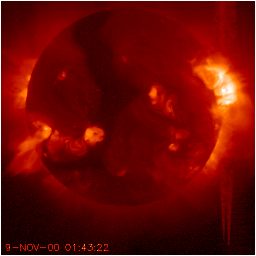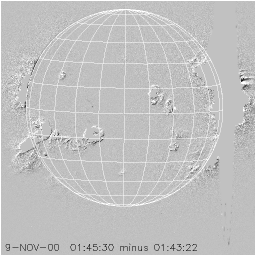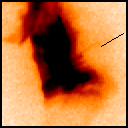
|

|
All of the data (including movies!) found in the earlier nuggets we've linked above come from SXT's "partial-frame images". During a flare, the Yohkoh telemetry is given over to small fields of view at the highest possible resolution, and when we learned (in about 1998) how to tweak the exposure times of these images properly, we found the downflows, and it was a big thrill. Now it turns out the perhaps we were seeing them all along in our "full-frame images", ie the standard whole-Sun composite images that are widely distributed.
A SAD is a "Supra-Arcade Downflow", and the one presented here occurred November 6, 2000. Here's a standard whole-Sun image(left) and a difference of two images from somewhat late in this event (times indicated in the time history plot):

|

|
The spiky arcade shows up nicely in the image on the left, above the NW limb of the Sun. The difference image, from images separated by two minutes, shows white and black structures in the spikes above the arcade, indicating that the spikes are waving about. The movie of whole-Sun images shows this dynamic action clearly. So, let us look at the usual partial-fram images and see what's going on with better time resolution.
We find downward motion in the form of an apparently shrinking arcade loop, as designated in the movie frame below (colors reversed to show faint features better):

The interpretation here is that this is a shrinking arcade loop, seen edge-on; in the initial discovery of the "SAD" phenomenon, and in many of the examples found later, the downward flow field best exhibits itself in apparently dark features streaming through and along the spiky arcade. Here it's a bit different, and gives more of the flavor of the standard post-reconnection shrinkage phenomenon. Although there's no real theoretical work on this vitally important phenomenon yet, the best bet must be that the flows, even though at the Alfven speed as we half-expected, do show the exhaust flow from large-scale coronal reconnection following the flare and CME. After all this editorializing, here's the movie:

As usual, the arcade itself is heavily overexposed in these long-exposure images, and in this hasty reduction we have not tried to improve the flickering. But the shrinking loop and other above-the-arcade motions are on display well enough.
We've recently (just this year, 2000) changed our standard observing program. Now, instead of one 5-sec exposure every 8 minutes, we get sets of four; this basically quadruples the sampling of the standard Yohkoh movie. We feel that this represents a big step forward in our ability to see variability in the corona, and this SAD is one of the rewards. Because Yohkoh observations are entirely constrained by telemetry bandwidth, we've had to give something up - in the new observing mode we have less ability to determine coronal temperatures, and we have less ability to do whole-sun photometry of bright things. But on the whole it seems like an excellent improvement.
29 December, 2000